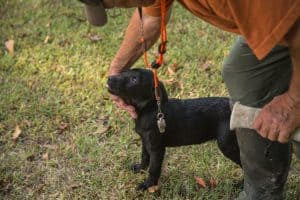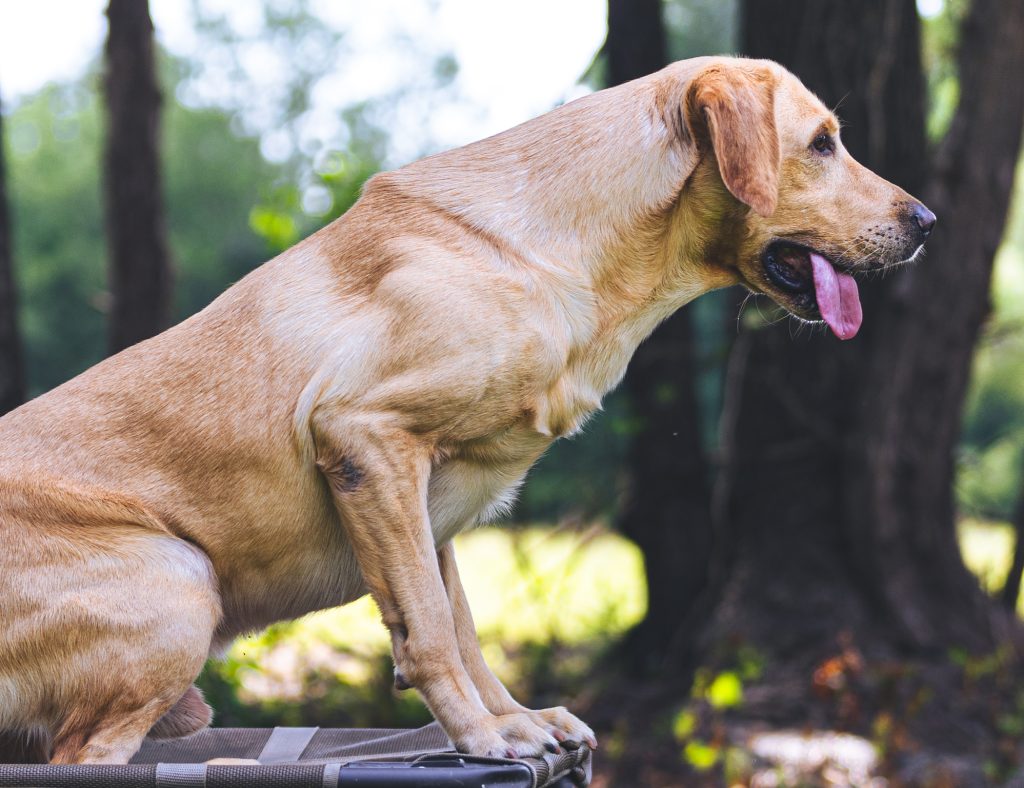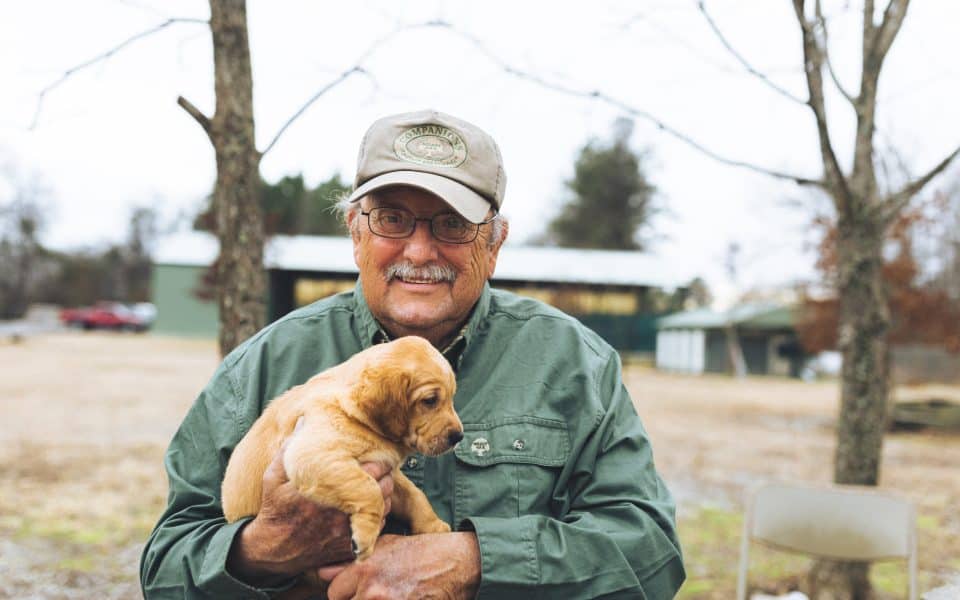While there are diverse opinions about the cause of dysplasia in dogs unfortunately there is no “cut and dry” test to identify pups with future dysplasia issues. The bottom line is that no one fully understands the onset and progression of hip dysplasia. Some agree that it is not a genetic defect but it is a direct result of overfeeding and over-exercising a young pup.

Riley Payne
While others suggest the more commonly held theory that hip and elbow dysplasia is caused by a combination of three factors: genetics, nutrition and exercise. In fact, many of my fellow trainers in the United Kingdom believe that over the long term, twenty percent of puppies will experience some degree of dysplasia ranging from mild to severe. Their observations, based on years of breeding experience, are probably true. Certainly, overfeeding and the resulting impact of weight on their limbs, when combined with excessive exercise and genetics, can and does negatively affect the pup’s muscular and skeletal development.
Our personal view that every puppy in a litter has passable hips and elbows when they are born. Therefore, to us, dysplasia is a condition that presents during the growth stage(s) in young puppies. In both hips and elbows, dysplasia is characterized by a loosening of the joint(s) causing an abnormal gait and pain that becomes more noticeable as the dog ages. Two of the notable signs of hip dysplasia in a puppy, are (1) “bunny hopping” when running, i.e moving both hind limbs in tandem which appears like a hopping motion similar to that of a rabbit and (2) a popping sound or feel in the hip joint(s) when walking. The onset of elbow dysplasia becomes noticeable when the puppy limps on one or both of the front legs. Over time, the dog’s lameness becomes more evident as it limits the dog’s mobility. So what can one do to decrease the odds of a puppy developing severe hip and or elbow dysplasia?
Puppy Selection
 First, you should search everywhere and exercise due diligence during your search to insure that you get a healthy puppy from a reputable breeder. You should carefully review both the sire and dam’s health records that are posted on the breeder’s website. Make an effort to verify the posted outcomes on the OFA website and other DNA recessive gene testing websites or by reviewing records at the breeder’s kennel. After assuring yourself that the breeder has in fact health tested the pup’s sire and dam and both parents had passing hip and elbow scores, you should be ready to move forward and make a deposit on your puppy. After getting your puppy around seven weeks of age, you’ll want to do your best to prevent the development of hip and or elbow dysplasia by focusing on the remaining two elements: limiting exercise and proper feeding.
First, you should search everywhere and exercise due diligence during your search to insure that you get a healthy puppy from a reputable breeder. You should carefully review both the sire and dam’s health records that are posted on the breeder’s website. Make an effort to verify the posted outcomes on the OFA website and other DNA recessive gene testing websites or by reviewing records at the breeder’s kennel. After assuring yourself that the breeder has in fact health tested the pup’s sire and dam and both parents had passing hip and elbow scores, you should be ready to move forward and make a deposit on your puppy. After getting your puppy around seven weeks of age, you’ll want to do your best to prevent the development of hip and or elbow dysplasia by focusing on the remaining two elements: limiting exercise and proper feeding.
Limiting Exercise
A most important factor in decreasing the likelihood of your puppy developing hip and or elbow dysplasia is limiting exercise to a reasonable level. When puppies are born, the bones in their hind legs and forelegs do not touch. After laying around for two or three weeks, they begin to crawl, then stand and eventually begin to walk. At this stage, they are clumsy, their movement is wobbly and they frequently fall over. The joints in their hind legs and forelegs are made up of loosely fitting soft bones, muscle, ligaments, and tendons with the skin actually holding everything together. At this stage in their growth, none of their hip joints or elbow joints are joined together and the growth plates will not harden until they approach the age of eight months and possibly extending to as old as eighteen months.
 In terms of exercise, this is significant because over-exercising during this developmental period places undue stress on their joints. It will most likely will contribute to the development of dysplastic hips and or elbows. Again, over-exercising the puppy can and will likely damage their forming joints. So, from an exercising standpoint, what can you do to lessen the likelihood of dysplasia? We recommend the following advice:
In terms of exercise, this is significant because over-exercising during this developmental period places undue stress on their joints. It will most likely will contribute to the development of dysplastic hips and or elbows. Again, over-exercising the puppy can and will likely damage their forming joints. So, from an exercising standpoint, what can you do to lessen the likelihood of dysplasia? We recommend the following advice:
8 Tips for lessening the Likelihood of Dysplasia in dogs
- Don’t take the young puppy out and have him running to retrieve for an extended amount of time. Instead, take him for short walks, maybe fifteen minutes or less and give him no more than one or two retrieves each day.
- Don’t let the puppy jump in or out of a vehicle, jump on and off of furniture, jump over obstacles or any similar activity that places high impact on the hind legs or forelegs. Instead, lift him up or down.
- Don’t leave a puppy on a high surface so that he can jump off. Again, this can negatively impact his hind legs and forelegs.
- Don’t put any pressure on his rear to encourage him to sit. Instead, teach early sit at feeding time. This is done by holding his food bowl up high, using the “sit” command and moving forward towards the pup until he sits. As you lower the food bowl, if the pup stands, raise it back up and repeat the “sit” command. After a couple of lessons, the puppy should learn to readily sit and stay seated until he is allowed to eat.
- Don’t let the puppy walk on tile floors or other slick surfaces where traction is limited because it could damage the puppy’s joints.
- Don’t let the young puppy run beside you while you are running or riding a bike.
- Be careful when holding your puppy so that you do not drop it. This is very important when being held by a young child.
- Don’t walk the puppy on hard pavement. Walking a puppy on hot pavement could burn his pads. Instead, walk with him on grass or other soft surfaces.
By being mindful and with strict adherence to these guidelines, you are doing everything possible to lessen the potential for the onset and progression of hip and elbow dysplasia.

Rob Kinney
Proper Nutrition
During the weening process, we begin by feeding Sportsman’s Pride small kibble puppy food that is high in protein and fat (32% protein and 21% fat). At the onset, we mix the kibble with water and grind it in a blender until it is in a liquid form. We feed this wet kibble twice a day because at this growth stage the pup’s bones and muscles are rapidly growing; thus, requiring a highly nutritious diet. As the day’s pass, we reduce the water content until we are only feeding dry kibble with a little canned puppy food. For the puppies that we keep for the kennel, we continue with dry puppy kibble, gradually reducing the amount of canned food until the pup is three months old. At this age, we gradually switch over to Sportsman’s Pride Field Master Adult food (26% protein and 18% fat). It is our belief that by switching the puppy’s food at three months, we effectively slow the growth rate and maintain an ideal weight; thereby, allowing normal bone growth and muscular development. An overweight condition could contribute to the onset and severity of hip and elbow dysplasia.
By limiting exercise, maintaining a healthy weight and practicing low-impact training and playtime, you can decrease the likelihood of having a dysplastic puppy.








